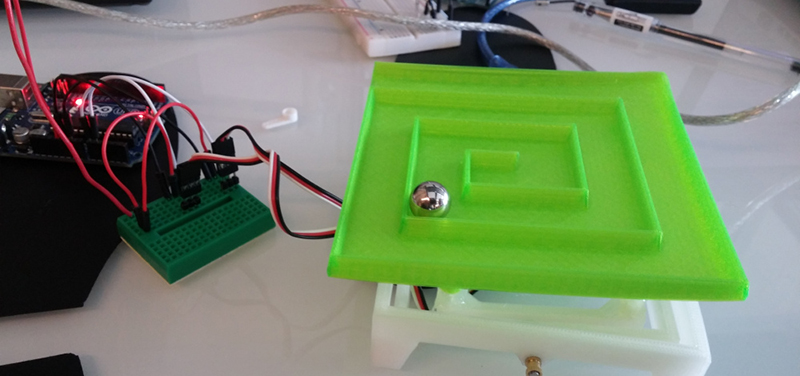[Daniel], [Gal] and [Maxim] attended a hackathon last weekend – Brainihack 2015 – that focused on neuroscience-themed builds in a day and a half long build off. The trio are communications systems engineering and computer science students with no background in neuroscience whatsoever. You can’t build an FMRI in a day and a half, so they ended up winning the best project in the open source category with a brain-controlled labyrinth game.
The labyrinth itself is entirely 3D printed and much, much simpler than the usual, ‘wooden maze with holes’ that’s generally associated with labyrinth puzzles. It’s really just a plastic spiral for a ball to follow. There’s a reason for this simplicity. The team is using EEG to detect brain waves and move the labyrinth on the X and Y axes.
The team is using OpenBCI for the interface between their brains and a pair of servos. This is actually an interesting piece of tech; unlike a few toys like the NeuroSky MindWave and the Star Wars Force Trainer, the OpenBCI gives you eight input channels that attach to anywhere on the scalp. The team used these inputs to measure Alpha waves and Steady State Visually Evoked Potential to control the pair of servos on the labyrinth frame.
It’s a great build, a wonderful demonstration of a device that outputs real EEG signals, and the team on a prize. What’s not to like?
















This OpenBCI looks interesting but why is it 450$?
The most expensive part seems to be the ADC which is 50$ for a single one.
Ok, a µC, accelerometer and RF.. but I don’t think this will fill the margin.
How much do you sell yours for? I might like to order one.
A friend of mine is doing her master in neural engineering and we thought about building our own BCI already. Unfortunately we simply don’t have the time for such projects anymore..
I mean for a low volume item, you got the $50 ADC plus a BLE module, with the board and all the accessories I bet the BOM comes close to $100, plus labor, overhead, and margin; $450 is not that unreasonable. I’m mad I can’t afford it, but hey, that’s how it goes sometimes.
Because it is a research tool, it’s built in low volume which raises the price significantly. Also, they probably use the difference for development.
Kind of like the Arduino…. the genuine one costs a lot more than the parts because the rest is used to support the software development. When you buy a clone you give nothing back to the people who develop the sw.
That does seem steep. I paid ~$200 for a Zeo several years ago, which has a ttl serial port you can tap into to get a feed of brain waves.
What’s not to like? The missing W in the second to last sentence, otherwise a nice project.
When I read the headline, I thought of a creepy cellar, filled with mice brains spiked with electrodes, floating in aquariums filled with red glowing goo.
Yeah, that was my hope too, color me dissapointed
Is such a cellar still “creepy” if it coordinates with the rest of the house? :) Just asking … for a friend.